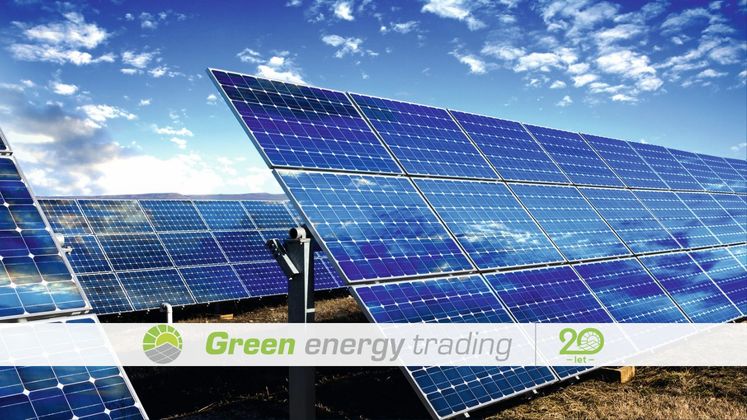How are solar panels made?
 30. 9. 2025
30. 9. 2025
Solar panels may look like complex devices because they convert sunlight into usable, 100% clean energy for our homes. But they are actually quite simple. In this article, we will explain how solar panels are made and what they are made of.
What are solar panels made of?
Solar panels are made from four basic materials: silicon, metal, glass and plastic. Each component has a specific purpose:
- Silicon forms the solar cells that are part of the solar panel and convert sunlight into electricity.
- Metals form the protective frame that protects the panel and holds it in place. Solar panel frames are usually made of aluminium.
- Glass covers the silicon solar cells and protects them from the elements.
- Plastic acts as a backing layer that protects the rear of the panel.
Some other materials are also used, such as sealants that hold the panels together, materials in the wiring and busbars that carry solar electricity to your home.
How are solar panels made?
How exactly do all these materials come together to form a functional solar panel? There are a few key steps to understand.
Step 1: Manufacturing solar cells
The process begins with the extraction of raw materials. Silicon is obtained from quartz minerals, which are mined and purified to separate the silicon. Solar cell manufacturers use high temperatures to grow a silicon ingot, which is essentially one large block of silicon that is sliced into wafers.
Silicon is a natural semiconductor, but it is usually ‘doped’ with boron or gallium to improve performance. Phosphorus is also used to make solar cells work as efficiently as possible.
The solar photovoltaic cell is then coated with an anti-reflective layer that allows more sunlight to reach the cell, increasing its efficiency. More sunlight means more excited electrons, which means more electricity for your home. Thin lines are then etched into the cells to capture and conduct the electrical current within the cell.
Some solar panel brands manufacture their own solar cells, while others purchase them from separate solar cell manufacturers.
Step 2: Connecting the solar cells
Once the solar cells are manufactured, the solar panel manufacturer connects them by soldering to form a sheet of cells. Most solar modules for homes have 60 cells, while commercial solar panels have 72 cells.
Step 3: Manufacturing the panel
Solar panels are not just a sheet of solar cells. Once the cells are connected, a backing film is added to protect the underside of the solar cells. The manufacturer then encapsulates the solar cells and backing film under a sheet of tempered glass and into a metal frame that provides stability.
Step 4: Installation of the junction box
The final step in the process is the installation of peripheral devices such as cable connections and junction boxes. Junction boxes are where the internal wiring of the solar panel meets the external connections, protecting them from the weather and other external factors.
Step 5: Testing the solar panels
Most manufacturers also subject the panels to rigorous testing to ensure product quality and efficiency. Any cracked or bent solar panels are discarded, and the rest are tested to ensure they can withstand intense weather conditions, heat, and normal wear and tear.
They are also tested to ensure that electrical current flows through the panel efficiently so that it can generate solar energy as intended.
Where are solar panels manufactured?
Most of the world's solar panels are manufactured in China. According to the International Energy Agency, China accounts for nearly 75% of global solar module production. Vietnam, India, Thailand, Malaysia and the United States also account for a portion of solar panel production.
What are the different types of solar panels?
Monocrystalline solar panels
Monocrystalline solar panels contain solar cells that are cut from a single silicon crystal. The uniform structure of a single silicon crystal ensures higher efficiency of the solar panel, which means higher energy production and greater savings on electricity bills.
Monocrystalline solar panels are slightly more expensive than other types, but they produce the most electricity and are the most popular type of solar panel used for home solar systems.
Polycrystalline solar panels
Polycrystalline solar panels use solar cells made from fragments of multiple silicon crystals. The fragments are melted, which allows for an easier and cheaper manufacturing process, but they do not produce electricity as efficiently as monocrystalline solar cells.
The manufacturing processes for monocrystalline solar cells have also become cheaper as the technology is used more and more, so the price difference between poly and mono solar cells is almost negligible.
Thin-film solar panels
Thin-film solar panels do not use solid silicon crystals, but instead use doped metal oxides called transparent conductive oxides (TCO). These films absorb sunlight in a similar way to silicon wafers, but are flexible.
Thin-film panels are less efficient than most monocrystalline and polycrystalline panels, but they are flexible and can be installed on various surfaces, such as the curved roofs of caravans.
